Serviços Personalizados
Journal
Artigo
Indicadores
-
 Citado por SciELO
Citado por SciELO -
 Acessos
Acessos
Links relacionados
-
 Similares em
SciELO
Similares em
SciELO
Compartilhar
Portugaliae Electrochimica Acta
versão impressa ISSN 0872-1904
Port. Electrochim. Acta vol.30 no.4 Coimbra jul. 2012
https://doi.org/10.4152/pea.201204261
Hot-pressed Ag+ Ion Conducting Glass-Polymer Electrolytes: Synthesis and Battery Application
Angesh Chandra*
Department of Applied Physics, Shri Shankaracharya Institute of Professional Management & Technology, Raipur - 492015, C.G., India
Abstract
Synthesis of new Ag+ ion conducting glass-polymer electrolytes (GPEs): (1-x) PEO: x [0.75(0.75AgI:0.25AgCl):0.25(Ag2O:P2O5)], where 0 < x < 50 wt. (%), are reported. GPEs have been casted using hot-press techniques. The highest conducting composition 70 PEO: 30 [0.75(0.75AgI:0.25AgCl):0.25(Ag2O:P2O5)], with conductivity (σ) ~ 6.0 × 10-6 S cm-1, was identified from the compositional dependent conductivity studies and this has been referred to as the Optimum Conducting Composition (OCC). Approximately three orders of conductivity enhancement have been achieved in GPE OCC from that of the pure polymer PEO. The glass-polymer complexation has been confirmed by SEM and DSC analysis. Ion transport parameters viz. ionic conductivity (σ), ionic mobility (μ), mobile ion concentration (n) and ionic transference number (tion) have been characterized using different experimental techniques. Solid-state polymeric batteries were fabricated using GPE OCC as electrolyte and the cell-potential discharge characteristics were studied under different load conditions at room temperature.
Keywords: glass polymer electrolytes, hot-press method, SEM, DSC, polymer battery.
Introduction
The development of new solid-state dry electrolytes with both high conductivity and limited reactivity with electrodes are of great attention recently [1, 2]. After the demonstration of the first solid polymer battery in 1979 [3], a large number of solid polymer electrolytes (SPEs), involving different mobile ions viz. Li+, Na+, K+, Ag+, etc., have been investigated. Among the known electrolytes, solid polymer electrolytes (SPEs) based on high molecular weight dielectric polymer hosts, generally polyethylene oxide (PEO), seem the most suitable electrolytes for solid state device applications. Their ether groups solvate lithium-ions in the same manner as crown ethers, and confer low reactivity, increasing safety. However, the room temperature conductivities of PEO-based polymer electrolytes are in the range of 10-7 to 10-8 S cm-1 because of low effective carrier mobility in the largely crystalline material below the transition temperature [4, 5]. The PEO-based flexible solid polymer electrolytes (SPEs)/ glass-polymer electrolytes (GPEs) show tremendous technological potential to develop ion conducting devices viz. polymer batteries, sensors, smart windows and other electrochemical devices. In a recent work, a number of glass polymer electrolytes (GPEs) have been developed for solid state device applications, which show high ionic conductivity by stabilizing the highly conductive amorphous phase, improve the electrode-electrolyte interfacial stability by trapping residual impurities, extend shelf-life by decreasing PEO recrystallization rate and increase in ion-transference number [5-8]. SPE/ NCPE/ GPE films are prepared, in general, by a traditional solution-cast method. However, recently a novel hot- press technique has been developed for casting SPE/ NCPE films [9-13]. In the present paper, we report the synthesis of a new Ag+ ion conducting PEO- based glass polymer electrolyte (GPEs): (1-x) PEO: x [0.75(0.75AgI:0.25AgCl): 0.25(Ag2O:P2O5)], where 0 < x < 50 wt. (%), using the hot-press method. The glass-polymer complexation and materials characterization are also reported with the help of SEM and DSC analysis.
Experimental
The AR grade precursor chemicals: poly (ethylene oxide) PEO (105 Mw, Aldrich,
USA), AgI (purity >98%, Reidel India), AgC1 (>99%, Reidel India), Ag2O
(>98%, Reidel India) and P2O5 (>99%, Reidel India) have been used for
synthesis of new Glass Polymer Electrolytes (GPEs): (1-x) PEO: x
[0.75(0.75AgI:0.25AgCl): 0.25(Ag2O:P2O5)], where 0
A new Ag+ ion conducting solid-state polymeric battery was also fabricated in the following cell configuration:

The cell performances were studied under different load conditions at room temperature.
Results and discussion
Fig. 1 shows the compositional dependence of room temperature conductivity for the silver phosphate glass electrolytes: [y (0.75AgI:0.25AgCl)+(1-y) (Ag2O:P2O5)], where y is expressed in mol. wet. %, and it is synthesized by the melt-quenching technique [14].
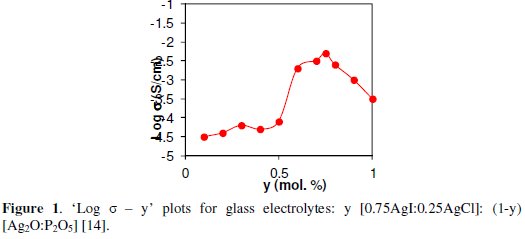
The conductivity of the glass system increased initially and attained a peak value of x = 0.75, then decreased. The highest conducting composition: 0.75 [0.75AgI: 0.25AgCl]: 0.25 [Ag2O: P2O5], with room temperature conductivity s ~ 5.5 × 10-3 S cm-1, has been used as a host salt for synthesis of glass polymer electrolytes (GPEs): (1-x) PEO: x [0.75(0.75AgI:0.25AgCl): 0.25(Ag2O: P2O5)], where 0 < x < 50 in wt. (%).
Fig. 2 shows the room temperature conductivity (σ) variation with different salt concentrations for hot-pressed GPEs. The conductivity (σ) increased abruptly (~103 times) after the addition of the salt in the host polymer.
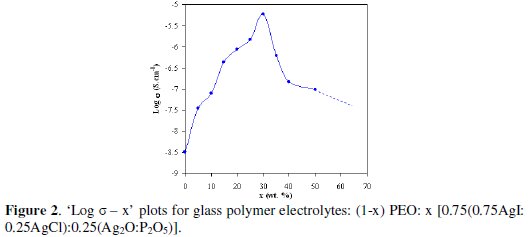
However, a moderate sized σ-maxima appears at x = 30 wt.(%) and then decreases on further addition of salts. The GPE films beyond 50 wt. (%) salt concentration were conductivity (σ ~ 6 × 10-6 S cm-1), exhibited optimum conductivity and this has brittle and appeared physically less stable. The GPE film: 70PEO: 30[0.75(0.75AgI:0.25AgCl): 0.25(Ag2O:P2O5)], with room temperature been referred to as Optimum Conducting Composition (OCC). The three orders of conductivity enhancement in GPE OCC are due to the increase in the degree of amorphousity/ decrease in degree of crystallinity from that of the pure PEO.
The surface morphology of GPE OCC was observed by scanning electron micrograph (SEM), as shown in Fig. 3.
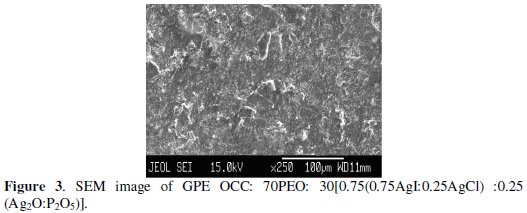
The smooth surface morphology of GPE OCC is clearly indication of increase in the degree of amorphousity/ reduction in the crystallinity of pure PEO after salt complexation. This is due to the cross- linking with the polymer and the host glassy salts. The thermal properties of GPE OCC and pure PEO have been characterized with the help of very useful DSC technique. Fig. 4 shows the DSC thermogrames for the pure PEO and GPE OCC.
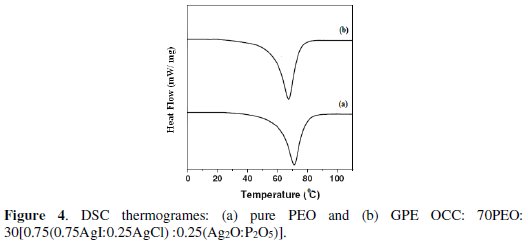
The broad endothermic peak was observed in SPE OCC at ~ 65-67 °C and it corresponds to the melting point temperature of pure PEO. The slightly shifting in the melting point temperature towards lower side is due to the complexation of Ag+ ion to the ether oxygen of pure PEO and it is also indicative of the formation of GPEs.
To explain the ionic nature of the present GPE system, the ionic transference number (tion) measurement was also carried out at room temperature, as mentioned in Experimental Section. Fig. 5 shows the 'current versus time' plot for the solid state GPE cell: [SS// GPE OCC// SS], at room temperature.
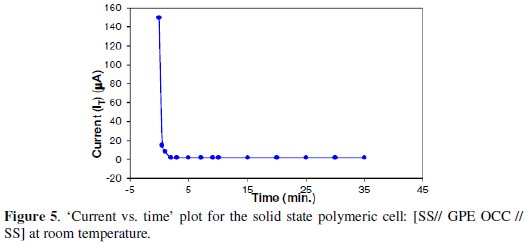
The tion of GPE OCC was calculated with the help of the following equation:

where Ie is the electronic current and IT is the total current of the cell: [SS / GPE OCC / SS]. tion ~ 0.98 has been obtained by using the above equation and it indicated that the majority of the charge carriers (~ 98 %) are cation Ag+, with only a very small contribution (~ 2 %) of the others. tion is close to unity and hence the present GPE systems are very much suitable for the preparation of solid-state electrochemical cells and other ion conducting devices.
Fig. 6 shows the cell potential discharge profiles for the solid state polymeric cell under different loads viz. 100 kW, 50 kW at room temperature, as mentioned in Section 2.
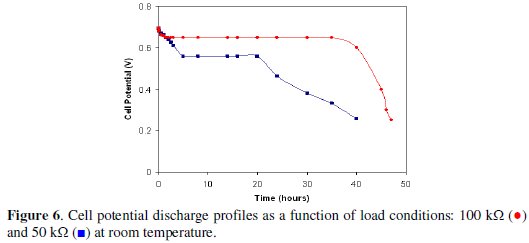
The Open Circuit Voltage (OCV) ~ 0.68 V has been obtained for both the cells. It can be clearly noticed that except for the initial potential drop, OCV value remained practically stable for ~ 35 and ~ 15 hrs. when discharged through 100 & 50 kW, respectively (i.e., during a low current drain state). However, the cell potential decreased relatively faster when discharged through 50 kW load (i.e., during higher current drain states). Hence, a GPE based newly polymer battery, performed fairly satisfactorily especially under low current drains.
Conclusions
A new Ag+ ion conducting glass-polymer electrolyte: 70PEO: 30[0.75 (0.75AgI:0.25AgCl):0.25(Ag2O:P2O5)] has been synthesized using a novel hot- press technique. Three orders of conductivity enhancement were observed in the GPE from that of the pure polymer. Materials characterization has been done by SEM and DSC analysis. A solid state polymer battery was fabricated and discharge characteristics were studied at room temperature. The GPE battery performed satisfactorily under low current drains.
References
1. Scrosati B, Croce F, Persi L. J. Electrochem. Soc. 147 (2000) 1718.
2. Sun HY, Sohn H-J, Yamamoto O, Takeda Y, Imanishi N. J Electrochem Soc. 1999;146:1672.
3. Armand MB, Chabgano JM, Mundy M, Shenoy GK. Fast Ion Transport in Solids. North Holland; 1979. [ Links ]
4. Persi L, Croce F, Scrosati B, Plichta E, Hendrickson MA. J Electrochem Soc. 2002;149:A212.
5. Appetecchi GB, Croce F, Dautzenberg G, Mastragostino M, Ronci F, Scrosati B, Soavi F, Zaneli A, Alessandrini F, Prosini PP. J Electrochem Soc. 1998;145:4126.
6. Kumar B, Schaffer JD, Nookala M, Scanlon LG. J Power Sources. 1994;47:63. [ Links ]
7. Cho J, Liu M. Electrochimica Acta. 1997;42:1481. [ Links ]
8. Zhang XW, Wang C, Appleby AJ, Little FE. J. Power Sources 112 (2002) 209.
9. Appetecchi GB, Croce F, Hassoun J, Scrosati B, Salomon M, Cassel F. J. Power Sources. 2003;114:105.
10. Agrawal RC, Chandra A. J Phys D Appl Phys. 2007;40:7024. [ Links ]
11. Chandra A, Chandra A. Hot-Pressed Polymer Electrolytes: Synthesis and Characterization. Germany; Lambert Academic Publisher; 2010. [ Links ]
12. Chandra A, Chandra A, Thakur K. Port Electrochim Acta. 2012;30(2):81. [ Links ]
13. Chandra A, Chandra A, Bhatt A, Thakur K. Int J Chemistry. 2012;1(2):209. [ Links ]
14. Agrawal RC, Gupta RK, Bhatt A, Verma ML, Chandra A. Ionics. 2004;10:126.
15. Chandra S, Tolpadi SK, Hashmai SA. Solid State Ionics. 1988;28-30:651. [ Links ]
*Corresponding author. E-mail address: chandrassi@gmail.com
Received 24 November 2012; accepted 22 December 2012














